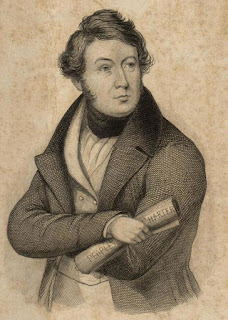RE: Treasure case - Medieval annular brooch from Langstone
Oliver Blackmore, the Collections and Engagement Officer at Newport Museum and Art Gallery, has recently acquired a brooch under the Portable Antiquities Scheme in Wales (PAS Wales).
Dr Mark Redknap from National Museum Wales, comments
- the decorative medieval brooch inlaid with niello is 13th or 14th
Century. [Niello is a black mixture, usually of sulphur, copper, silver, and
lead, used as an inlay on engraved or etched metal, especially silver. It is
added as a powder or paste, then fired until it melts or at least softens, and
flows or is pushed into the engraved lines in the metal.]
DescriptioNiello is a black mixture, usually of sulphur, copper, silver, and lead, used as an inlay on engraved or etched metal, especially silver. It is added as a powder or paste, then fired until it melts or at least softens, and flows or is pushed into the engraved lines in the metal.Worn primarily as dress-fasteners, this particular brooch form has a curved crossbar to prevent snagging of textile," he said, adding similar examples had been found in Abergavenny, the Vale of Glamorgan, Flintshire, Breconshire and on Anglesey.
Description of the brooch
The reported object is a small annular brooch. The silver frame is of a circular cross-section. One hoop face is decorated with continuous transverse incised lines inlaid with black niello, the other with six groups of transverse incised lines inlaid with black niello. The two sides of the wrap-around head meet at the top, and the pin rotates around the frame. The four pin shaft facets are engraved with irregular zig-zag lines (less well executed on the reverse, almost as straight lines), as is the short stirrup and the head.
External hoop diameter 18.9 x 16.5mm; hoop thickness 1.5mm. The pin and head overall length is 19mm; the stirrup width is 8.5mm; the brooch weight is 1.69g. The object has not undergone any cleaning or conservation.
Metal Content
To judge
from its colour and weight and visual comparison with brooches and other silver
dress accessories in the collections of the Department of History &
Archaeology, the alloy is well in excess of 10% silver.
In terms of size and design, the brooch is of a thirteenth to mid-fourteenth-century form. Brooches with similar forms have been found in deposits in London dated c.1270-1350 (e.g. Egan & Pritchard 1991, no. 1314). Examples from Wales include brooches from Trelawnyd & Gwaenysgor Community, Flintshire (Treasure case 16.16), St Brides, Vale of Glamorgan (TAR 2003, no. 411), Llantarnam (TAR 2003, no, 410), Llanfaes, Anglesey (Redknap 1994, no.14), and a near identical example to the Langstone example from Cilcain Community, Flintshire (Treasure Case 2017.11).
Many similar silver brooches have been found. This one missing its pin, was discovered by Mr Kevin Higgs while metal detecting on 24th April 2019. It was found in a field under pasture in Ambleston Community, Pembrokeshire and dates to the 13th-mid-14th centuries. Arrangements are being made for Scolton Manor Park & Museum to acquire the brooch.
What is considered Treasure and what changes have been made recently to the definition of treasure in order to increase protection for archaeological finds? Now for the first time, the official treasure definition is not based solely on the material qualities of an artefact. These changes make the treasure process more transparent and efficient for museums and the public.






Comments
Post a Comment